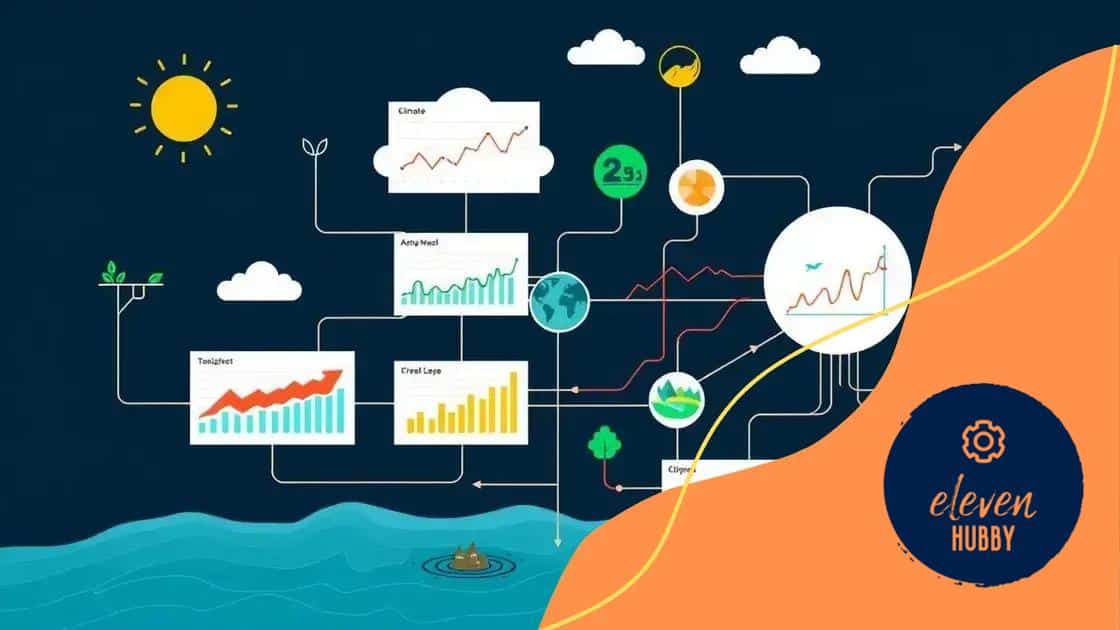The role of big data in fighting climate change

The role of big data in fighting climate change is crucial, enabling accurate predictions, enhancing sustainability efforts, and facilitating data-driven decisions for a healthier planet.
The role of big data in fighting climate change is more significant than ever. By analyzing vast amounts of data, we can uncover insights that drive impactful environmental strategies. Have you ever wondered how data shapes our understanding of climate patterns?
Understanding big data and its significance
Understanding big data is essential in today’s world, especially in the fight against climate change. It involves analyzing vast amounts of data to discover patterns, correlations, and insights. By harnessing this information, researchers and policymakers can make smarter decisions that contribute to environmental sustainability.
One important aspect of big data is its ability to improve our understanding of climate trends. For example, when weather patterns are analyzed over decades, we can see changes that indicate the impact of human activities on the planet. This data helps us to monitor outcomes and adjust strategies accordingly.
How Big Data Works
Big data relies on various technologies to collect, store, and analyze information. These technologies include:
- Cloud computing: Stores massive data sets in remote servers.
- Data mining: Extracts useful information from large data volumes.
- Machine learning: Helps analyze data and predict outcomes.
- Data visualization: Converts data into visual formats, making it easier to understand.
These technologies allow us to sift through large amounts of data quickly and efficiently, leading to timely insights that were not possible before.
The Significance of Big Data in Climate Awareness
Understanding the significance of big data can greatly impact how we approach climate initiatives. By utilizing these data streams, we can:
- Track greenhouse gas emissions accurately.
- Optimize energy consumption in real-time.
- Enhance predictive models for climate events.
The ability to monitor and analyze climate data has never been more crucial. It not only informs our understanding of current environmental challenges but also prepares us for future scenarios.
In conclusion, big data offers valuable insights that are vital in addressing climate change. As we continue to gather and analyze data, our capacity to make informed decisions improves, ultimately supporting the planet’s health.
How big data enhances climate modeling
How big data enhances climate modeling plays a crucial role in understanding our environment. By leveraging vast amounts of data, scientists can create more accurate and detailed climate models. These models help us predict weather patterns, assess risks, and formulate effective strategies to combat climate change.
Data collection is essential for constructing these models. Through satellite imagery, weather stations, and ocean buoys, researchers gather information about temperatures, humidity, and other factors. This information is processed to analyze how different variables interact over time.
The Role of Data in Climate Models
Data fuels climate modeling in several ways:
- Improved accuracy: More data leads to better predictions.
- Long-term trends: Analyzing historical data reveals changes.
- Scenario testing: Models can simulate various conditions to forecast outcomes.
As data sets grow, the models become increasingly sophisticated. They can account for the complexities of our climate system, including feedback loops and human impacts. Additionally, advancements in computing power allow us to process these large data sets more efficiently.
Examples of Big Data in Climate Modeling
There are many examples of how big data is used effectively in climate modeling. For instance, researchers can use real-time data from ocean buoys to track temperature and salinity changes. This information is vital in predicting how ocean currents will shift, impacting global weather patterns.
Another example includes the use of machine learning algorithms. These tools can analyze data and recognize patterns that are difficult for humans to detect. This capability enhances our understanding of climate dynamics, enabling scientists to develop policies that can mitigate adverse effects.
Ultimately, the integration of big data into climate modeling significantly enhances our ability to respond to climate change. By improving predictions and understanding interactions within the climate system, we can take decisive actions toward a sustainable future.
The role of data analytics in sustainability

The role of data analytics in sustainability is vital for creating efficient environmental solutions. By examining large sets of data, organizations can identify patterns that help them make informed decisions. This process enables them to implement strategies that reduce waste and improve resource management.
Data analytics helps businesses understand their environmental impact. For example, analyzing energy consumption patterns can lead to adjustments that enhance efficiency. Companies can use this information to set clear goals for reducing carbon footprints and promoting sustainability.
How Data Analytics Works in Sustainability
Data analytics uses several techniques to drive sustainability:
- Predictive analytics: Forecasts future trends based on historical data.
- Benchmarking: Compares performance against industry standards.
- Dashboard reporting: Visualizes data for easier decision-making.
These tools help organizations evaluate their sustainability efforts. For instance, predictive analytics can forecast how changes in operations affect greenhouse gas emissions. This information is essential for making adjustments to meet environmental goals.
Real-World Applications of Data Analytics
Many companies use data analytics to enhance their sustainability efforts. For example, a company may analyze supply chain data to find inefficiencies. By addressing these issues, they can reduce waste and decrease costs. Another example includes cities that analyze transportation data to improve public transit options, reducing traffic and emissions.
As organizations embrace data analytics, they can develop innovative solutions for sustainability challenges. With the right tools and techniques, they can track progress over time and adapt strategies as needed. Ultimately, data analytics empowers businesses and communities to promote a healthier planet.
Case studies: successful big data applications
Case studies: successful big data applications illustrate how organizations use data effectively to address challenges, especially in sustainability and climate change. These examples showcase the transformative power of big data in the real world.
One notable case is the collaboration between IBM and the city of Los Angeles. They utilized big data analytics to manage traffic flow better. By analyzing various data points, including historical traffic patterns, weather conditions, and special events, the city was able to reduce congestion significantly.
Environmental Monitoring through Big Data
Another example involves the environmental organization Global Forest Watch. They use satellite imagery and big data to monitor deforestation in real time. This data helps governments and NGOs respond quickly to illegal logging activities.
- Real-time alerts: Immediate notifications about changes in forest cover.
- Data accessibility: Open data allows anyone to analyze forests.
- Partnerships: Collaboration with governments to implement policies.
This application of big data not only raises awareness but also aids in enforcing sustainable practices.
Corporate Sustainability Initiatives
Many companies adopt big data strategies to enhance sustainability. For instance, Walmart analyzes massive data sets to optimize its supply chain. This process reduces waste and improves efficiency in product delivery. By controlling inventory levels and minimizing excess, they can cut down on unnecessary environmental impact.
Additionally, companies like Unilever utilize data analytics to improve sourcing practices. They track suppliers’ adherence to sustainable practices, ensuring responsible production methods and transparency in their operations.
These case studies provide insights into how big data applications lead to meaningful change. By learning from these successes, other organizations can implement similar strategies to enhance their sustainability efforts.
Future trends in big data for climate action
Future trends in big data for climate action are shaping how we address climate change. With advancements in technology, we can expect significant developments in how data is collected, analyzed, and utilized. These trends will enable more effective climate strategies.
One major trend is the increasing use of real-time data analytics. As more sensors are deployed around the world, we can monitor environmental changes instantly. This immediacy allows for quicker responses to climate-related events. For example, real-time data can help predict natural disasters, enhancing emergency preparedness.
Artificial Intelligence and Machine Learning
Another transforming factor is the integration of artificial intelligence (AI) and machine learning into big data analysis. These technologies can identify patterns in data that humans might miss. By harnessing AI, scientists can develop predictive models that provide insights into future climate scenarios.
- Enhanced forecasting: Models become more accurate with AI analysis.
- Automation: Reduces human error in data interpretation.
- Cost-effectiveness: Helps organizations analyze large data sets efficiently.
By applying machine learning algorithms, climate experts can enhance their understanding of how different factors influence climate change over time.
Improved Collaboration through Data Sharing
Collaboration will also play a crucial role in future big data applications. As organizations share data, they can develop comprehensive strategies for climate action. Platforms that allow data sharing will enable researchers to combine their findings and create unified approaches to environmental challenges.
This trend fosters global partnerships among governments, NGOs, and businesses. Together, they can address climate change more effectively. For instance, shared data can lead to coordinated efforts in renewable energy projects and conservation initiatives.
In summary, the future of big data in climate action looks promising. With advancements in technology and improved collaboration, we can expect more significant strides toward sustainability. These trends are encouraging as we work together to protect our planet.
In conclusion, big data plays a critical role in fighting climate change and enhancing sustainability efforts. By developing accurate predictive models, organizations can make informed decisions that lead to positive environmental impacts. The future trends in big data, such as real-time analytics and AI, will drive even greater advancements. As collaboration grows among scientists, governments, and businesses, we can better tackle climate challenges together. Embracing big data not only helps us understand environmental dynamics but also empowers us to create actionable solutions for a sustainable future.
\n\n
\n
FAQ – Frequently Asked Questions about the Role of Big Data in Fighting Climate Change
How does big data help in understanding climate change?
Big data allows scientists to analyze vast amounts of information, revealing patterns and trends that can predict environmental changes and impacts.
What are some examples of big data applications in sustainability?
Examples include monitoring deforestation with satellite imagery and optimizing supply chains to reduce waste in companies like Walmart.
How is AI integrated with big data for climate action?
AI enhances big data analysis by identifying complex patterns and making predictions that improve climate models and strategies.
Why is collaboration important in using big data for climate solutions?
Collaboration allows for data sharing among governments, NGOs, and businesses, leading to more comprehensive and effective climate action initiatives.






